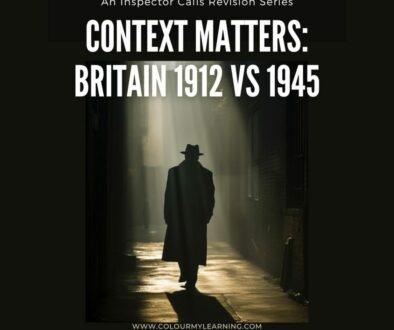What Makes An Inspector Calls a Morality Play?
J.B. Priestley’s An Inspector Calls may be set in Edwardian England, but its structure, characterisation, and message borrow heavily from an older dramatic tradition, the morality play. In this article, we’ll explore what defines a morality play and how Priestley adapts this classic form to challenge a 20th-century audience.
By the end, you’ll understand how the play’s structure and symbolism help deliver Priestley’s message about responsibility, justice, and the possibility of moral change. All of which are key themes for your GCSE or IGCSE English Literature essays.
When you are ready to practise writing essays, take a look at Past Exam Questions compiled for An Inspector Calls.
What Is a Morality Play?
To understand why An Inspector Calls is often called a modern morality play, let’s start with the basics.
Morality plays were a form of allegorical drama popular in medieval and early Renaissance England. Their purpose was clear: to teach audiences how to live virtuously and avoid sin. Instead of realistic characters, they used symbolic figures like “Everyman”, “Good Deeds”, “Pride”, or “Greed”. These plays showed the spiritual journey of an ordinary person tempted by vice and eventually led to redemption or ruin.
Key features of a morality play:
- Moral message: A lesson about right and wrong
- Symbolic characters: Represent ideas rather than individuals
- Dramatic structure: A journey from ignorance to awareness
- Audience engagement: A call to self-reflection and personal change
Although Priestley’s play is rooted in 20th-century realism, many of these elements appear in An Inspector Calls — reshaped for a modern audience.
Priestley’s Modern Take on a Classic Form
Rather than a direct copy of medieval theatre, An Inspector Calls is a modern morality play as it uses realistic characters and contemporary issues to present its message.
Priestley was writing in 1945, just after the Second World War. His audience had just lived through global conflict, social upheaval, and rapid political change. His message then, that we are all responsible for one another, felt both urgent and necessary.
A Moral Message at Its Core
At the heart of the play is a clear ethical lesson: we must care for others, particularly those who are vulnerable or powerless. The Inspector’s final speech makes this message impossible to miss:
“If men will not learn that lesson, then they will be taught it in fire and blood and anguish.”
This warning is not just to the Birlings, it is also to the audience. The “lesson” refers to social responsibility: the idea that our actions affect others and that we must act with empathy, fairness, and integrity.
Inspector Goole: The Voice of Conscience
In morality plays, there’s often a figure who represents moral authority, a guide who helps the main character (or audience) understand right from wrong. In An Inspector Calls, that figure is clearly Inspector Goole.
He is not a typical police inspector. His knowledge is uncanny. His questions are strategic. He seems more interested in truth and guilt than legality or evidence. By the end of the play, we are encouraged to see him as a symbol of moral reckoning, perhaps even a supernatural figure (consider his name a play on the word ghoul).
Goole as an Allegorical Character
Much like the “Everyman” guide in medieval plays, the Inspector pushes each character to confront their actions and reflect on their values. He doesn’t represent the law, instead he represents justice in a deeper sense. This is why many critics see him as an embodiment of conscience, morality, or even socialist ideals.
Key quote:
“We are members of one body. We are responsible for each other.”
This line summarises the play’s ethical core — and positions Goole as its messenger.
The Birlings: Flawed and Symbolic
While the Inspector acts as moral compass, the Birling family and Gerald Croft represent different attitudes to responsibility, privilege, and change.
Characters as Moral Types
Although the play is grounded in realism, each character also symbolises a broader idea:
- Mr Birling stands for capitalist self-interest and ignorance of social duty.
- Mrs Birling represents class prejudice and cold charity.
- Sheila becomes a figure of moral growth, symbolising the younger generation’s capacity for change.
- Eric shows the dangers of irresponsibility, but also the possibility of redemption.
- Gerald reveals how kindness can be undermined by self-preservation.
- Eva Smith, though unseen, represents the working-class victims of societal neglect.
This symbolic approach aligns closely with the morality play tradition — using characters not just as individuals, but as representatives of moral ideas.
Dramatic Structure: From Ignorance to Insight
Another reason the play resembles a morality play is its structure. The dramatic arc follows a progression from comfort and denial to guilt and awareness, at least for some characters.
A Clear Journey of Judgement
The play is almost entirely set in one room, across a single evening, with the Inspector as the controlling force. One by one, he interrogates the Birlings, exposing their links to Eva Smith. This format allows Priestley to:
- Build dramatic tension steadily
- Reveal each character’s flaws and choices
- Allow space for reflection and argument
This confessional structure mirrors the journey of a morality play, where the protagonist faces temptations, recognises their sins, and ideally reforms.
Audience Involvement and Final Impact
Morality plays were meant to encourage audiences reflect on their own lives. An Inspector Calls does the same.
Priestley doesn’t just want us to judge the Birlings. He wants us to look inward and ask:
- How do we treat others?
- What responsibility do we have to people we may never meet?
- Do we ignore injustice because it’s inconvenient?
The fact that Eva Smith never appears on stage makes her even more symbolic. She could be anyone, or everyone. She stands for all those whose voices are unheard and whose suffering is ignored.
Why It Still Matters Today
The power of An Inspector Calls lies in its ongoing relevance. Although written in 1945 and set in 1912, its message continues to resonate to this day. Themes of inequality, social justice, generational conflict, and the ethics of power remain central concerns in modern society.
Calling it a morality play is accurate not just because of its structure but mainly because of its purpose. Like the best examples of the genre, it asks its audience to think, to feel, and to change.
Exam Tip: How to Use This in Your Essay
If you’re writing about the play’s form, structure, or Priestley’s message, mentioning that An Inspector Calls is a morality play can strengthen your argument.
Here’s how:
Point: Priestley draws on the structure and purpose of a morality play to deliver his social message.
Evidence: The Inspector’s final speech warns, “If men will not learn that lesson…”
Technique: This is a didactic moment, typical of morality plays, urging the audience to reflect and change.
Analysis: By using this dramatic tradition, Priestley connects the Birlings’ personal failings to wider societal responsibilities — and challenges the audience to take action.
Conclusion
Although An Inspector Calls appears in the first instance to be an entertaining detective drama. Once we being to analyse it, we find that it is a carefully constructed morality play that uses symbolism, dramatic tension, and powerful language to deliver a lasting moral lesson.
Whether you’re analysing the role of Inspector Goole, exploring the theme of responsibility, or writing about the play’s form and structure, recognising its roots in morality theatre will help give your analysis extra depth.
Want to go further? Grab our An Inspector Calls Complete Revision Guide packed with detailed theme breakdowns, quote analysis, essay plans and past paper practice. You can find more information about our An Inspector Calls Revision Guide and other free resources on An Inspector Calls: Revision Resources Page.










